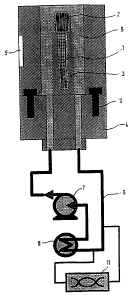Some of the information on this Web page has been provided by external sources. The Government of Canada is not responsible for the accuracy, reliability or currency of the information supplied by external sources. Users wishing to rely upon this information should consult directly with the source of the information. Content provided by external sources is not subject to official languages, privacy and accessibility requirements.
Any discrepancies in the text and image of the Claims and Abstract are due to differing posting times. Text of the Claims and Abstract are posted:
| (12) Patent: | (11) CA 2331211 |
|---|---|
| (54) English Title: | METHOD FOR PRODUCING AC-225 BY IRRADIATION OF RA-226 WITH PROTONS |
| (54) French Title: | PROCEDE DE PRODUCTION D'ACTINIUM-225 PAR IRRADIATION DE RADIUM-226 AU MOYEN DE PROTONS |
| Status: | Deemed expired |
| (51) International Patent Classification (IPC): |
|
|---|---|
| (72) Inventors : |
|
| (73) Owners : |
|
| (71) Applicants : |
|
| (74) Agent: | ROBIC |
| (74) Associate agent: | |
| (45) Issued: | 2008-09-23 |
| (86) PCT Filing Date: | 1999-05-26 |
| (87) Open to Public Inspection: | 1999-12-09 |
| Examination requested: | 2003-12-17 |
| Availability of licence: | N/A |
| (25) Language of filing: | English |
| Patent Cooperation Treaty (PCT): | Yes |
|---|---|
| (86) PCT Filing Number: | PCT/EP1999/003651 |
| (87) International Publication Number: | WO1999/063550 |
| (85) National Entry: | 2000-11-02 |
| (30) Application Priority Data: | ||||||
|---|---|---|---|---|---|---|
|
This invention refers to a method for producing Actinium-225, comprising the
steps
of preparing a target (1) containing Radium-226, of irradiating this target
with protons
in a cyclotron and of chemically separating Actinium from the irradiated
target material
thereafter. According to the invention the proton energy in the cyclotron is
adjusted such
that the energy incident on the Ra-226 is between 10 and 20 MeV, preferably
between
14 and 17 MeV. By this means the yield of production of the desired isotope Ac-
225 is
enhanced with respect to other radioisotopes.
Cette invention a trait à un procédé de production d'actinium-225 consistant à préparer une cible contenant du radium-226, à irradier cette cible au moyen de protons dans un cyclotron et à séparer par voie chimique l'actinium du matériau constituant la cible irradiée. On adapte, dans le cadre de cette invention, l'énergie des protons dans le cyclotron, de manière que l'énergie incidente au Ra-226 soit comprise entre 10 et 20 MeV, de préférence entre 14 et 17 MeV. On arrive, de ce fait, à accroître la production de l'isotope désiré, Ac-225, en comparaison de celle des autres radio-isotopes.
Note: Claims are shown in the official language in which they were submitted.
Note: Descriptions are shown in the official language in which they were submitted.

For a clearer understanding of the status of the application/patent presented on this page, the site Disclaimer , as well as the definitions for Patent , Administrative Status , Maintenance Fee and Payment History should be consulted.
| Title | Date |
|---|---|
| Forecasted Issue Date | 2008-09-23 |
| (86) PCT Filing Date | 1999-05-26 |
| (87) PCT Publication Date | 1999-12-09 |
| (85) National Entry | 2000-11-02 |
| Examination Requested | 2003-12-17 |
| (45) Issued | 2008-09-23 |
| Deemed Expired | 2017-05-26 |
There is no abandonment history.
| Fee Type | Anniversary Year | Due Date | Amount Paid | Paid Date |
|---|---|---|---|---|
| Registration of a document - section 124 | $100.00 | 2000-11-02 | ||
| Application Fee | $300.00 | 2000-11-02 | ||
| Maintenance Fee - Application - New Act | 2 | 2001-05-28 | $100.00 | 2001-04-05 |
| Maintenance Fee - Application - New Act | 3 | 2002-05-27 | $100.00 | 2002-02-14 |
| Maintenance Fee - Application - New Act | 4 | 2003-05-26 | $100.00 | 2003-01-09 |
| Request for Examination | $400.00 | 2003-12-17 | ||
| Maintenance Fee - Application - New Act | 5 | 2004-05-26 | $200.00 | 2004-04-26 |
| Maintenance Fee - Application - New Act | 6 | 2005-05-26 | $200.00 | 2005-04-27 |
| Maintenance Fee - Application - New Act | 7 | 2006-05-26 | $200.00 | 2006-04-25 |
| Maintenance Fee - Application - New Act | 8 | 2007-05-28 | $200.00 | 2007-04-25 |
| Maintenance Fee - Application - New Act | 9 | 2008-05-26 | $200.00 | 2008-04-25 |
| Final Fee | $300.00 | 2008-07-08 | ||
| Maintenance Fee - Patent - New Act | 10 | 2009-05-26 | $250.00 | 2009-04-24 |
| Maintenance Fee - Patent - New Act | 11 | 2010-05-26 | $250.00 | 2010-04-27 |
| Maintenance Fee - Patent - New Act | 12 | 2011-05-26 | $250.00 | 2011-04-26 |
| Maintenance Fee - Patent - New Act | 13 | 2012-05-28 | $250.00 | 2012-04-27 |
| Maintenance Fee - Patent - New Act | 14 | 2013-05-27 | $250.00 | 2013-04-26 |
| Maintenance Fee - Patent - New Act | 15 | 2014-05-26 | $450.00 | 2014-04-24 |
| Maintenance Fee - Patent - New Act | 16 | 2015-05-26 | $450.00 | 2015-04-23 |
Note: Records showing the ownership history in alphabetical order.
| Current Owners on Record |
|---|
| EUROPEAN COMMUNITY (EC) |
| Past Owners on Record |
|---|
| APOSTOLIDIS, CHRISTOS |
| JANSSENS, WILLEM |
| KOCH, LOTHAR |
| MCGINLEY, JOHN |
| MOLINET, ROGER |
| MOLLENBECK, JOSEF |
| OUGIER, MICHEL |
| SCHWEICKERT, HERMANN |
| VAN GEEL, JACQUES |